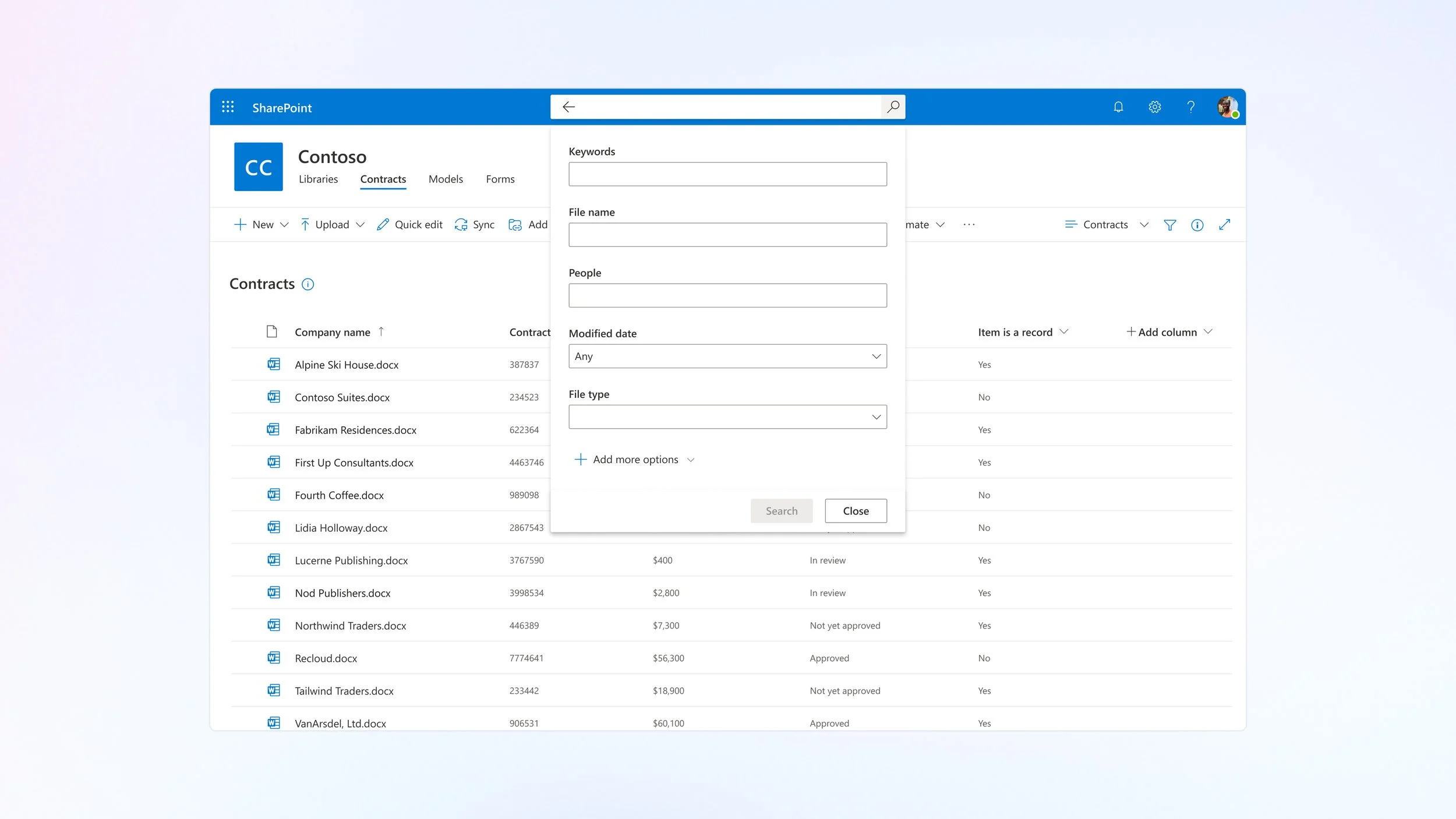ADVANCED SEARCH (MICROSOFT SYNTEX)
As part of the Microsoft Syntex suite, Advanced Search offers a premium, intelligent way to locate specific documents within a library by leveraging extracted metadata. Designed to dramatically reduce the time spent searching, it moves beyond SharePoint’s traditional keyword-based search by enabling users to find content based on precise, structured data.
Challenge
Customers struggled to find content efficiently within their document libraries. Many avoided using keyword search altogether, relying instead on manually organized folders, views, and browsing—an approach they admitted was time consuming and not ideal. For those who did use search, the experience was often frustrating, offering limited filtering options and returning overwhelming pages of results.
Design Lead
As the lead and sole designer, I led the end-to-end design process in close collaboration with product, engineering, and research. A key component of this project involved integrating AI models that extract metadata from documents, enabling the search experience to return more relevant, accurate results. Crafting a cohesive story between AI capabilities and the user-facing experience required thoughtful coordination and iteration.
A look before…
Keyword search alone wasn’t meeting customer needs. While it performed reasonably well for basic queries, more targeted or complex searches revealed significant pain points in the experience, leaving users frustrated and without the results they needed.
Research intake & analysis
Early insights guided us in defining a clear North Star vision, a realistic MVP, and a plan for iterative growth over the coming year. Continuous conversations with users, especially our core group of internal customers, revealed key insights that shaped both the user experience and product direction.
Key Findings & Principles
A traditional query builder felt too complex and unnecessary for most users.
The experience needed to be scalable and systematic—designed to grow with user needs and content complexity.
Growth opportunities, particularly around smarter search refinement and AI-assisted discovery.
Understanding the user journey
We quickly realized that search is not a one-size-fits-all solution, flexibility and adaptability were key. This understanding became a guiding light as we evolved the experience to meet the changing and varied needs of our users.
Accounts payable / Accounts receivable
A customer calls in with a question about their statement. The call center employee asks the customer for their name, account number and the month of the statement in question. They then execute a search and can see all the notes that have been made internally about this invoice.
Human resources (Recruiter, HR staff)
- A recruiter is looking for all resumes submitted since last Tuesday for job ID 231569 where status is "new" or "in Review".
- An HR pro wants to call up an employees W2 as there was an inquiry about a potential error.
Insurance claims
A field agent is heading to a site and must pull up all relevant documents associated with a specific claim.
Designed for flexibility, not uniformity
The advanced search experience wasn’t designed to be a one-size-fits-all solution. Instead, it served as a thoughtful starting point, aimed at addressing the most common user needs while allowing room to grow. Based on research, we identified the top five most frequently used parameters: Keyword, File Name, People, Modified Date, and File Type. These became the foundation for our baseline experience, ensuring we focused on the highest-impact features from the start.
Customer feedback showed that around 70% of users found the core experience sufficient for completing most of their daily search tasks.
As the experience evolved, we introduced contextual search options that adapted based on the type of document and the AI models used to extract metadata. Rather than overwhelming users with every possible filter, we surfaced only the most relevant options—driven by the metadata available for each file type. For example, if a document contained project-specific fields or customer-related tags, those would appear as filterable parameters. This approach allowed the search experience to stay streamlined while still offering depth when needed, creating a smarter, more intuitive way for users to narrow results based on meaningful context.
A home for Advanced search
After extensive cross-organizational discussions, it became clear that changing the default behavior of the search bar would be a complex, long-term effort. To move more quickly, we introduced a launch point that opened the advanced search experience as a separate flow. While this solution initially presented some discoverability challenges, we were able to mitigate those through targeted design updates and usability improvements
Experience results
80% of users found relevant result within the first page
Refinement rate dropped by 60%
In collaboration with business planning and PM, engaged with five potential businesses to validate their pain points and needs, resulting in targeted solutions that led to full product adoption







